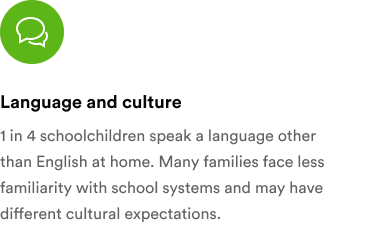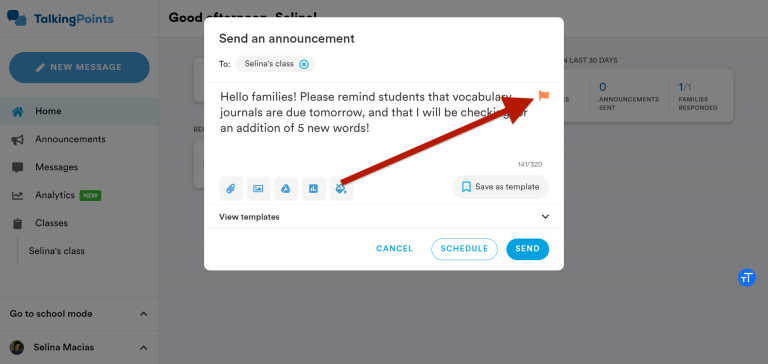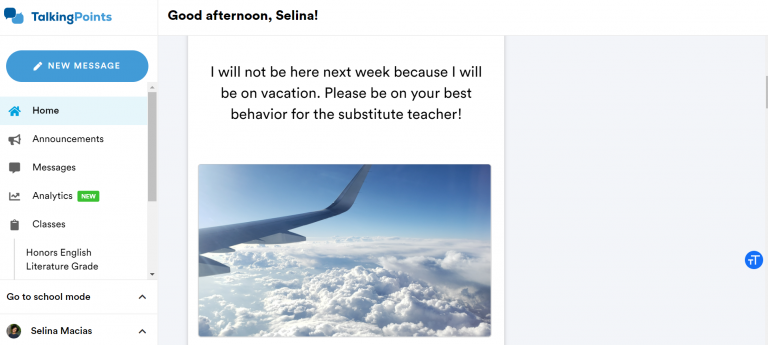Written by Paige DeLozier
We’re constantly working to provide a more efficient and effective channel of communication for teachers and families. Accurate translation into 145 languages is an essential part of that work.
Why Translation?
1 in 4 schoolchildren speak a language other than English at home. This creates a language barrier to family engagement that many teachers are not equipped to overcome without support. TalkingPoints is not only here to provide translation for your messages to families, but to help you be proactive in writing messages that will translate accurately for all families in all languages.

We know you have a lot to say to families and we believe implementing some core best practices when composing your messages will create effortless communication between you and your families.
Tips for Writing for Translation
When writing for a multilingual audience, certain expressions don’t always translate the way we intend. The original text serves as a base for content in other languages. Therefore, it’s extremely important that the message in the original language is written as clearly as possible because it will impact the other languages it’s translated into. To avoid confusion, here are some tips to keep in mind when writing for translation.
- Write Short, Simple Sentences
- Use Proper Grammar
- Avoid Specialized Language
- Decide What Will Stay in English
- Use Specific Vocabulary
- Use Active Voice
- Utilize Visuals
- Know How International Dates are Formatted

1. Write short, simple sentences
Writing long sentences in English will complicate the translation process and increase the chance of confusion (especially given the varying literacy levels of families). Keeping texts simple and concise fosters more effective communication. For these reasons, we have the readability flag feature, which notifies teachers when a sentence is likely too complex for non-English speakers.

2. Use proper grammar
Because mistakes can travel from the original language to target languages, ensure correct grammatical structure and proper punctuation. These errors can lead to incorrect translation and cause confusion:
- Run-on Sentence: Johnny was late today, what time did he leave for school, did you know that he has been late three times this week already.
- Correction: Johnny was late today. What time did he leave for school? He has been late three times this week.
- Lack of capitalization: Hi all–please remember that we are joining st. paul middle for the excursion to the museum of Natural History tomorrow. We will meet in the downstairs lobby.
- Correction: Hi all–please remember that we are joining St. Paul Middle School for the excursion to the Museum of Natural History tomorrow. We will meet in the downstairs lobby.
3. Avoid specialized language
- Idioms- Idioms such as “beat around the bush” may have a clear meaning in English, but most likely will not in other languages.
- Acronyms- these abbreviations will most likely have different letters for the words they represent in other languages. It is best to spell these words out for accurate translation.
- Professional Jargon and Colloquial Terminology- Medical, legal and other professional jargon, regional phrases, and figures of speech rarely translate with equivalency. It’s best to use clear, simple language to avoid misunderstandings.
4. Decide what will stay in English
Some information needs to stay in English to avoid confusion. Although we recommend keeping this to a minimum (no more than twice per message), utilizing curly braces will keep texts from being translated. During the translation process, text in curly braces will be kept in English. The final translation will include the original English text but will omit the curly braces. Here are some examples below:
- Place names: “During the field trip, we’ll stop at {Boston Common} for a break, before continuing on to {Old North Church}.”
- Addresses: “If you’d prefer, you can mail the signed form to {1234 Summer Street, City State Zip}.”
- Homework assignments: “Tonight, students should complete the {Silly Synonyms Worksheet}.”
- People’s names: If they represent common words, put them in brackets. “Hi, my name is {Joy Summer}, I will be your child’s 4th grade teacher this year.”

5. Use specific vocabulary
Words with multiple connotations can be confusing in other languages. It’s best to avoid words with various meanings and use direct vocabulary to describe situations.
Vague Wording
- Jenny was acting silly in class today and distracting the other students.
- Jenny made a silly drawing in class today and everyone loved it!
The word “silly” has positive and negative connotations, such as being funny or rambunctious. It’s better to use a word that specifically describes Jenny’s actions.
Correction
- Jenny was disruptive in class today and distracted the other students.
- Jenny made a hilarious drawing in class today and everyone loved it!
6. Use active voice
Sentences in the active voice have a strong, direct, and clear tone. Using an active voice relates a transparent, assertive message.
- Passive Voice A): The reason Brett arrived to school late today was because his stomach felt nauseous.
- Passive Voice B): The squirrel was chased by the dog.
- Active Voice A): Brett arrived to school late because he was nauseous.
- Active Voice B): The dog chased the squirrel.
7. Include visuals
Providing visuals of what is being translated can increase comprehension and understanding from the target audience. At times, a graphic can make a huge difference in clarifying what you’re expressing.

8. Know how international dates are formatted
In the U.S., dates are written as the month, day, and year.
- Example: 09/07/2021.
In other countries, dates are written as the day, month, and year.
- Example: 07/09/2021
The date and the month could be misinterpreted by families if they haven’t yet adjusted to how dates in the U.S. are formatted. For accuracy, it’s best to spell out the name of the month and then put the date. If space is tight, using an abbreviation for the month is fine too.
- Example: September 7, 2021 or Sep. 7, 2021
Help Me Understand
Communication barriers aren’t only created by language, but also by literacy. Many families in the communities we serve lack formal education and send messages to teachers that are often misspelled or otherwise confusing. This sometimes causes the translation to come through in a way that doesn’t quite make sense.
We created the “Help Me Understand This” button for incoming messages with spelling/grammatical errors or mixing of English and home languages that are difficult to understand. With this tool, our translators will take a second look at the translation provided to ensure that you are able to fully understand it!

![]()
Want to learn more?
TalkingPoints’ easy-to-use platform, interactive features, and precise translation in 145 languages can provide game-changing solutions for bridging the home-school gap for teachers, school districts, and families. Learn more about our services here, and contact us at hello@talkingpts.org to learn more about how TalkingPoints can increase family engagement, improve home-school connections, enhance relationships between teachers and families, and support academic and social-emotional growth for every student.



